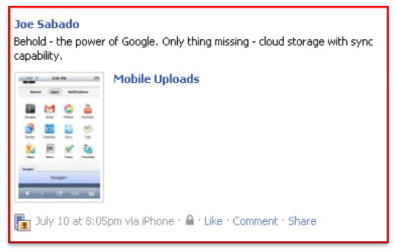Update: This article “Google adds enterprise social networking features to Google+” (Aug 29, 2012) is what I was expecting when I wrote this blog post below, days after Google+ was released in July, 2011.
Some may consider me an avid social media user. I enjoy using social media and mobile devices for personal and professional use. When Google+ was introduced a couple of weeks ago, I was very intrigued by its features including the following:
- Circles provide a way of categorizing Google+ contacts into groups. This feature also borrows from twitter in that there’s no mutual approval needed to be connected.
- Huddle is a group messaging system via your mobile phone.
- Hang out is a group video chat up to 10 people.
- Sparks is a personalized content feed based on your interests
- Instant Upload provides users ability to upload images/videos to their private album from their mobile phones.
- Checkin which provides user ability to “checkin” like foursquare and facebook Places.
I was particularly impressed with the concepts of Circles because it seems to be so much more straightforward than facebook in managing lists and thereby easier to target the recipients of your posts.
As much as I enjoy and see the value of social media, mobile devices and cloud for personal use, I also look at these technologies (commonly referred to as consumer technologies) from a different perspective, that of a higher education IT leader who provides technology services to multiple student affairs departments. From my professional perspective, I look at Google+ in terms of what does it mean to my organization. Can it possibly add value and what are the challenges that come along with using this new social network if we were to adopt it? What really caught my attention was not Google+ itself but the integration of the different Google products on the top left of the header.
When I logged on to the site using my iphone, it became more apparent to me that the integration of these products:(GMail, YouTube, Calendar, Docs, Maps, Tasks) may just be the direction Google is heading, using Google+ as the possible hub of a cloud-based platform.
Based on the few days of my experience with Google+ and my limited knowledge of their other products/services , It seems to me that collectively the products/services below are components of a Google platform.
- Single Sign-on
- Social network/ sharing(Google+, YouTube, bookmarking, Blogger)
- Collaboration (Calendar, Docs, Tasks)
- Unified communication (Huddle, HangOut, Gmail, Voice)
- Browser (Chrome)
- Analytics
- Search
- Mobile OS (Android, Chromebook)
- Webstore
- Cloud storage (Docs, music)
The idea of a Google platform provides opportunities and challenges to organizations.
- IT organizations who provide enterprise computing must now compete with more choices like Google+ and other consumer technologies preferred by end-users who see these technologies as easier to use, faster to implement and cheaper to implement. How to stay relevant and how to continue providing value to the business will certainly be a challenge. Accepting the idea that the adoption of consumer technologies, like any or all of the Google components, in the workplace will continue to and that they must support will require a new way of thinking.Businesses and IT must work together to appropriately address issues associated with introducing consumer technologies and to take advantage of the benefits offered by them.
- The potential uses of Google+ has already been discussed by several advocates of social media in higher education, inside/outside the classrooms.
While Google+ by itself already provides new innovative features that are very useful to individual users, the idea of an integrated platform consisting of the different Google products/services presents both potential benefits and challenges to organizations.


2 Trackbacks / Pingbacks for this entry
July 16th, 2011 on 6:33 pm
[…] for Google+ in Higher Education from Hack Education, The Chronicle, Ed Cabellon & Joe Sabado] All things Google (Chromebook, OS, Apps & Plus) is becoming more appealing to educators. […]
January 3rd, 2012 on 2:41 pm
[…] wrote about Google Plus for universities much earlier, including Patrick Powers, Jeremy Littau, Joe Sabado, and […]